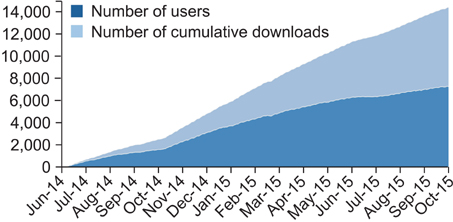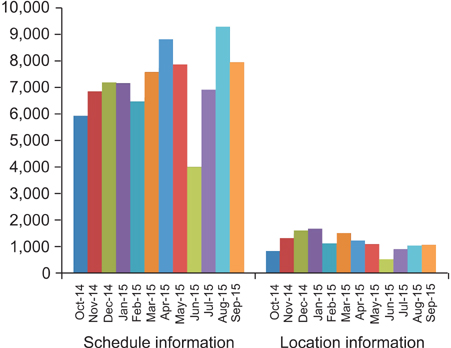Healthc Inform Res.
2016 Jul;22(3):172-177. 10.4258/hir.2016.22.3.172.
Development and Utilization of a Patient-Oriented Outpatient Guidance System
- Affiliations
-
- 1Center for Medical Informatics, Seoul Metropolitan Government-Seoul National University Boramae Medical Center, Seoul, Korea. kideb1@snu.ac.kr
- 2Center for Informatics, Seoul National University Bundang Hospital, Seongnam, Korea.
- 3Health Connect, Seoul, Korea.
- KMID: 2357395
- DOI: http://doi.org/10.4258/hir.2016.22.3.172
Abstract
OBJECTIVES
To develop a tool which can easily access the hospital information system (HIS) to facilitate outpatient care and maximize patient satisfaction on his or her hospital visit.
METHODS
Our Center for Informatics developed an outpatient guidance system (OGS) after careful analysis of the list of daily tasks undergone by patients and related work processes. Bluetooth beacons were installed to assist patients, to inform them of points of interest, and to guide them along the proper routes to and within the hospital.
RESULTS
The OGS conveniently provided patients' clinic schedules, routes to the hospital, and direct costs; all of this information was embedded in the HIS accessed from patients' personal mobile devices or kiosks. Patients were also able to identify their locations within the hospital, receiving proper directions to subsequent task. Since its launch in October 2014, the number of mobile accesses increased from 4,011 to 8,242 per month within a year.
CONCLUSIONS
The substantial growth of interest in and use of our OGS in such a short period indicate that this system has been successfully incorporated into patients' daily activities. We believe that this system will continue to help improve health services and the well-being of those visiting the hospital.
MeSH Terms
Figure
Reference
-
1. Kim YJ. Exploratory study on acceptance intention of mobile devices and applications for healthcare services. J Korea Contents Assoc. 2012; 12(9):369–379.
Article2. Rho MJ, Suh WS, Kwon J. Medical service factors associated with patient satisfaction: the difference between inpatient and outpatient of a medium-sized hospital. J Digit Converg. 2013; 11(2):331–339.3. Franko OI, Tirrell TF. Smartphone app use among medical providers in ACGME training programs. J Med Syst. 2012; 36(5):3135–3139.
Article4. Franko OI. Smartphone apps for orthopaedic surgeons. Clin Orthop Relat Res. 2011; 469:2042–2048.
Article5. Dayer L, Heldenbrand S, Anderson P, Gubbins PO, Martin BC. Smartphone medication adherence apps: potential benefits to patients and providers. J Am Pharm Assoc (2003). 2013; 53(2):172–181.
Article6. Kim HS, Jeong HS. A nurse short message service by cellular phone in type-2 diabetic patients for six months. J Clin Nurs. 2007; 16(6):1082–1087.
Article7. Kim SI, Kim HS. Effectiveness of mobile and internet intervention in patients with obese type 2 diabetes. Int J Med Inform. 2008; 77(6):399–404.
Article8. Benhamou PY, Melki V, Boizel R, Perreal F, Quesada JL, Bessieres-Lacombe S, et al. One-year efficacy and safety of Web-based follow-up using cellular phone in type 1 diabetic patients under insulin pump therapy: the PumpNet study. Diabetes Metab. 2007; 33(3):220–226.
Article9. Bramley D, Riddell T, Whittaker R, Corbett T, Lin RB, Wills M, et al. Smoking cessation using mobile phone text messaging is as effective in Maori as non-Maori. N Z Med J. 2005; 118(1216):U1494.10. Hurling R, Catt M, Boni MD, Fairley BW, Hurst T, Murray P, et al. Using internet and mobile phone technology to deliver an automated physical activity program: randomized controlled trial. J Med Internet Res. 2007; 9(2):e7.
Article11. Yoo S, Lee KH, Baek H, Ryu B, Chung E, Kim K, et al. Development and user research of a smart bedside station system toward patient-centered healthcare system. J Med Syst. 2015; 39(9):86.
Article12. Buijink AW, Visser BJ, Marshall L. Medical apps for smartphones: lack of evidence undermines quality and safety. Evid Based Med. 2013; 18(3):90–92.
Article
- Full Text Links
- Actions
-
Cited
- CITED
-
- Close
- Share
- Similar articles
-
- An Evaluation of a Patient Referral System using Intervention Analysis
- The Effects of Case Management for Medicaid on Healthcare Utilization by the Medicaid System
- Analysis of the current status outpatient utilization of medical and Korean traditional medical institutions: focuse on outpatient frequent outpatient diseases
- Application of ARCUS digma I, II systems for full mouth reconstruction: a case report
- Drug Utilization Review (DUR) Policy of Government and Directivity







